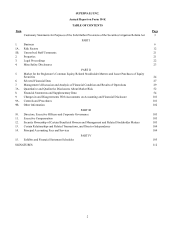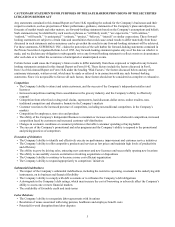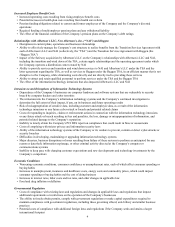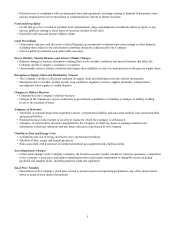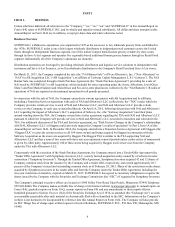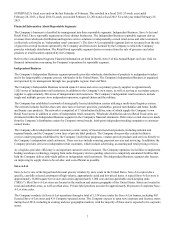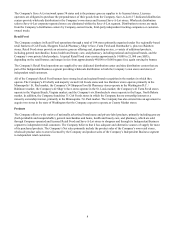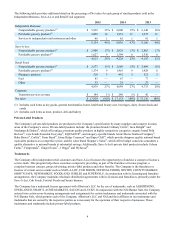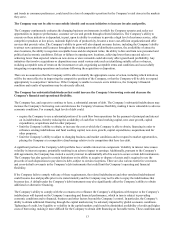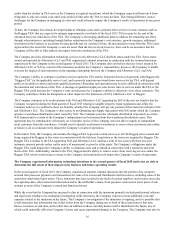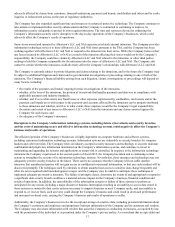Albertsons 2015 Annual Report Download - page 14
Download and view the complete annual report
Please find page 14 of the 2015 Albertsons annual report below. You can navigate through the pages in the report by either clicking on the pages listed below, or by using the keyword search tool below to find specific information within the annual report.12
(4) Ritchie L. Casteel was appointed President & CEO, Save-A-Lot in March 2013. Prior to joining the Company, Mr. Casteel
served as Director of Sales and Operations at Grocery Outlet Inc. from 2005-2009 and served as a Consultant for Hallmark
Cards, Inc. a manufacturer of greeting cards, from 2011-2013.
(5) Susan S. Grafton was appointed Senior Vice President, Finance, and Chief Accounting Officer effective in February 2014.
Prior to joining the Company, Ms. Grafton served as Senior Vice President, Controller and Chief Accounting Officer from
2011-2014 and Vice President, Controller and Chief Accounting Officer from 2006-2011 at Best Buy Co., Inc., a retailer of
consumer electronics and related products.
(6) Mark Van Buskirk was appointed Executive Vice President, Merchandising, Marketing, Retail & Pharmacy in March 2013.
Prior to joining the Company, Mr. Van Buskirk served as Vice President of Meat and Seafood Merchandising and
Procurement at the Kroger Co., a retail grocery company, from 2006-2013.
(7) Rob Woseth was appointed Executive Vice President, Strategy effective March 2013. Prior to joining the Company,
Mr. Woseth served as Vice President Business Development and Strategy at Albertson’s LLC from 2006-2013.
The term of office of each executive officer is from one annual meeting of the Board of Directors until the next annual meeting
of Board of Directors or until a successor is elected. Except as described above with respect to the appointment for Mr. Duncan,
there are no arrangements or understandings between any executive officer of the Company and any other person pursuant to
which any executive officer was selected as an officer of the Company. There are no family relationships between or among
any of the executive officers of the Company.
Each of the executive officers of the Company has been in the employ of the Company or its subsidiaries for more than five
consecutive years, except for Sam Duncan, Bruce H. Besanko, Randy Burdick, Ritchie L. Casteel, Susan S. Grafton, Mark Van
Buskirk and Rob Woseth.
ITEM 1A. RISK FACTORS
Various risks and uncertainties may affect the Company’s business. Any of the risks described below or elsewhere in this
Annual Report on Form 10-K or the Company’s other SEC filings may have a material impact on the Company’s business,
financial condition or results of operations.
The Company’s Independent Business, Save-A-Lot and Retail Food segments face intense competition.
The grocery business is intensely competitive, and the recent and ongoing consolidation within the grocery industry is expected
to result in increased competition, including from some competitors that have greater financial, marketing and other resources
than the Company. The nature and extent to which the Company’s competitors implement various pricing and promotional
activities in response to increasing competition and the Company’s response, or failure to respond effectively, to these
competitive actions, in a grocery industry characterized by relatively small gross margins, can adversely affect profitability and
the Company’s operating results.
The Company’s Independent Business segment is primarily wholesale distribution, which competes with traditional grocery
wholesalers as well as specialty wholesalers on the basis of price, quality, assortment, schedule and reliability of deliveries,
service fees and distribution facility locations. The profitability of the Independent Business segment is dependent upon
sufficient volume to support the Company’s operating infrastructure, which is dependent on the ability of the Company to
attract new customers and retain existing customers, as well as the ability of the Company and its independent retail customers
to distinguish themselves from competitors in the grocery channel. The Company’s Independent Business segment also faces
competition from retailers that maintain or develop self-distribution systems as a result of industry consolidation or otherwise.
The inability to attract new customers, the loss of existing customers to a competing wholesaler or due to closure, vertical
integration, or industry consolidation, or the inability of the Company’s customers to compete successfully with other grocery
retailers and non-traditional retailers may negatively impact the Company’s sales and gross margin.
The Company’s Save-A-Lot and Retail Food segments face significant competition for customers, managers, employees, store
sites and products from traditional grocery retailers, including regional and national chains and independent food store
operators, and non-traditional retailers, such as supercenters, membership warehouse clubs, specialty supermarkets, drug stores,
discount stores, dollar stores, convenience stores, online retailers and restaurants. Competitors continue to increase their
presence in the Company’s markets, including certain non-traditional competitors that have entered the grocery retailing
business. The Company’s ability to differentiate itself from its competitors and create an attractive value proposition for its
customers is dependent upon a combination of price, quality, customer service, convenience, assortment, in-stock levels, brand
perception, store location and conditions, in-store marketing and merchandising and promotional strategies. Any failure to
positively differentiate the Company’s stores, as well as the inability to identify and respond to changes in economic conditions


